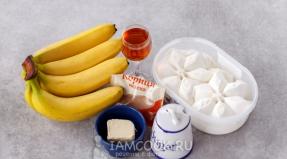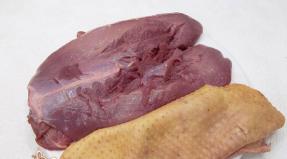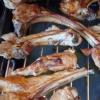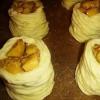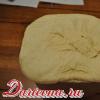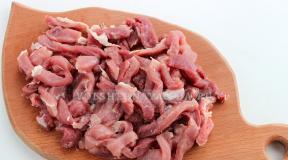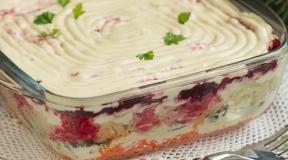Real Imereti khachapuri - the best cheese cake recipe! Imeretian khachapuri - step by step recipe Video of making Imeretian khachapuri.
Imeretian khachapuri is cooked in hot ketsi, in a pan or in the oven, and a special kind of fatty pickled cheese is used as a filling. The dough can be yeast or yeast-free, kneaded on matsoni, kefir or water.
The Georgian recipe for Imeretian khachapuri in the oven is quite simple. Yeast dough on water and dry yeast, unpaired, therefore quick and without hassle - it is easy to form closed khachapuri from it. As for the filling, the Imeretian cheese (it is difficult to find it here) is replaced by Suluguni or Adyghe. The difference between these two types of cheese in khachapuri will be significant. Suluguni melts well, while Adyghe will turn out to be drier. In addition, Suluguni is more salty, has a pronounced cheesy taste, while Adygei is fresh, and it needs to be salted, or even better, add a piece of more salty cheese to it.
Ready-made khachapuri must be oiled on top to make them softer, so stock up on good butter, fresh, without impurities and third-party smell.

Total cooking time: 70 minutes
Cooking time: 20 minutes
Output: 1 piece
Ingredients
for the test
- wheat flour - 200-250 g
- water - 125 ml
- dry yeast - 1 tsp
- refined vegetable oil - 1 tbsp. l.
- salt - 1 chip.
- sugar - 1 chip. generous
For filling
- Imeretinsky, Adyghe or Suluguni cheese - 300 g
- chicken egg - 1 pc.
- wheat flour - 0.5 tbsp. l.
- salt - 1-2 chips.
- butter - 20 g for lubrication
Cooking
Large photos Small photos
Let's start with a test. In a large bowl, in which we will conveniently knead the dough, pour warm water (about 30 degrees), add dry yeast, salt and sugar to it, pour in sunflower oil. Stir until the yeast is completely dissolved.

Gradually, in several stages, add the sifted flour, mixing the dough with a spatula, and then with your hands. The amount of flour may fluctuate depending on its moisture content and quality, therefore it is added in small portions, according to the principle “how much dough will take”.

Knead the dough for khachapuri well - at least 10 minutes, until it becomes soft and stops sticking to your hands. Sprinkle the finished bun with flour and cover with a cloth. Leave warm to approach for 40 minutes.

Meanwhile, prepare the filling for khachapuri. We rub the cheese (I used Adyghe) on a fine grater, drive an egg into it, a little salt and half a tablespoon of flour.

Thoroughly mix the filling and collect into a tight ball. Leave on the table, covering the bowl with cling film. Do not refrigerate, otherwise the filling will harden and it will be difficult for you to form cakes. By volume, the cheese filling should turn out to be a lot, about the same as the dough.

During this time, the dough will rise and rise about twice. We spread it on a sheet of parchment sprinkled with flour and crush it. It is convenient to roll out and form a cake on parchment paper, and most importantly, it can be transferred to a baking sheet along with the paper without deforming.

Flatten the dough with your hands into a round cake with a diameter of about 15 cm so that it can wrap around the filling. Place a cheese ball in the center.

We lift the edges of the dough, collecting it into a knot.

We pinch so that there are no holes and the filling does not flow out. Dust lightly with flour and flip down.

Gently flatten the workpiece into a flat and round cake - it should turn out to be large, about 30 cm in diameter, up to 2 cm thick. It is most convenient to work with your hands, gradually distributing the soft cheese inside the khachapuri. At the end, you can help yourself a little with a rolling pin to make the cake even on top.

We transfer khachapuri along with parchment to a baking sheet - I turn the baking sheet upside down so that the sides do not interfere. In the center I pinch off a little dough, thus making a hole through which hot steam will escape during baking.

We send the baking sheet to the oven, heated to 200-220 degrees. Bake for 15-20 minutes depending on the capacity of your oven. Readiness is determined by the appearance of the cake - as soon as the Imeretian khachapuri with cheese in the oven is reddened, it can be considered ready.

Grease the hot cake generously with butter and serve immediately. Serve with herbs, fresh vegetables and wine. Khachapuri in Imeretian style is hearty, full of fillings, with a soft and long-lasting dough. They are best served hot, although they are also very good cold. Try it yourself!

Imeretian khachapuri is one of the most common types of khachapuri. Dough for khachapuri can be prepared on matsoni, kefir or water, yeast or yeast-free. For cooking, as a rule, Imeretian cheese is used, but it is not sold in our area, so you can use suluguni or similar cheeses.
Imeretian khachapuri is cooked in hot ketsi, in a frying pan or in the oven. The authors of the site site have prepared various options for cooking Imeretian khachapuri at home. You will be surprised how easy it is to master the classic Georgian cuisine! All you need to do is follow the detailed instructions and know a few simple cooking tricks.
Often Imeretian khachapuri is cooked in a pan, as these are closed khachapuri that can be turned over, but in the oven they turn out to be no less attractive and fragrant, the main thing is to generously grease the finished khachapuri with butter.
Imereti Khachapuri in the oven
Ingredients:
For test:
- Water - 250 ml;
- Fresh yeast - 20 g;
- Flour - 400–450 g;
- Sunflower oil - 3 tbsp. l.;
- Salt - 0.5 tsp;
- Sugar - a pinch.
For filling:
- Suluguni cheese - 600 g;
- Egg - 1 pc.;
- Flour - 2 tsp
For lubrication:
- Butter - 30–40 g.

Cooking method:
Crumble fresh yeast into warm water, add salt and a pinch of sugar, pour in sunflower oil. Pour in 350 g of flour and mix the dough with a spatula. Then add flour gradually until you get a soft dough that sticks well from your hands. Cover the dough with a cloth and remove to approach in a warm place 2 times, it will take 30-40 minutes.
Let's get to the stuffing. Grate suluguni cheese. Crack the egg and add to the cheese. Also add a couple of teaspoons of flour. Stir the cheese mixture, divide in half. Gather one piece first. The dough for making khachapuri is ready.
We divide it into two parts. From one part we roll out a circle of such a size that a ball of cheese fits inside. Place a cheese ball in the center. Then we also prepare a cake from the second part of the dough. Gather the dough into a knot.
Then gently roll out the cake again, immediately with your hands so as not to tear the dough, then with a rolling pin. The thickness of the cake should be no more than 10 mm. We shift the cake onto parchment and put it on a baking sheet. Make a hole in the center of the cake with your finger to let the steam out.
Preheat the oven to 250 degrees and bake khachapuri for 10-11 minutes until the top is browned. The hot cake should immediately be greased with butter.
Khachapuri in Imereti on kefir
Ingredients:
For test:
- kefir (original matsoni) - 500 ml;
- salt - 1 teaspoon;
- sugar - 1 teaspoon;
- baking soda - 2/3 tsp;
- vegetable oil - 2 tbsp. spoons;
- flour - how much dough will take (about 600–700 g).
For filling:
- suluguni cheese (in the original Imeretian) - 800 g;
- eggs - 2 pcs.;
- butter - 60 g (+ 50–80 g for greasing khachapuri).

Cooking method:
Dissolve baking soda in a fermented milk drink, stir thoroughly until the powder is completely dissolved. Then we throw salt, sugar and pour in vegetable oil with a neutral aroma, mix.
Sprinkle flour in small portions. When the flour mass becomes thick enough, spread the contents of the bowl on a flat surface sprinkled with flour. Let's start kneading by hand. We let the soft dough for khachapuri “rest” for about 20 minutes, and in the meantime we prepare the filling.
Three large shavings of suluguni (or other similar cheese), add 2 eggs and melted butter. Stir the cheese mixture until smooth. From the dough we pinch off a piece the size of a peach, roll out a thin circle. In the center we place a plentiful portion of the cheese mass.
We lift the edges of the dough to the center and carefully pinch. We turn the “pie” seam down, gently stretch it with our hands into a cake, and then slightly flatten it with a rolling pin. Fry the tortillas in a dry frying pan over medium heat for 3-5 minutes on each side.
Such cakes are good with soups, broths, main courses. Bon Appetit!
Traditional Imeretian khachapuri
Ingredients:
for the test:
- wheat flour - 200-250 g;
- water - 125 ml;
- dry yeast - 1 tsp;
- refined vegetable oil - 1 tbsp. l.;
- salt - 1 pinch;
- sugar - 1 chip. generous.
For filling:
- Imeretinsky, Adyghe or Suluguni cheese - 300 g;
- chicken egg - 1 pc.;
- wheat flour - 0.5 tbsp. l.;
- salt - 1-2 slivers;
- butter - 20 g for lubrication.

Cooking method:
In a large bowl, in which we will conveniently knead the dough, pour warm water (about 30 degrees), add dry yeast, salt and sugar to it, pour in sunflower oil. Stir until the yeast is completely dissolved.
Gradually, in several stages, add the sifted flour, mixing the dough with a spatula, and then with your hands. The amount of flour may fluctuate depending on its moisture content and quality, therefore it is added in small portions, according to the principle “how much dough will take”.
Knead the dough for khachapuri well - at least 10 minutes, until it becomes soft and stops sticking to your hands. Sprinkle the finished bun with flour and cover with a cloth. Leave warm to approach for 40 minutes.
We rub the cheese on a fine grater, drive an egg into it, a little salt and half a tablespoon of flour. Thoroughly mix the filling and collect into a tight ball. Leave on the table, covering the bowl with cling film. By volume, the cheese filling should turn out to be a lot, about the same as the dough.
During this time, the dough will rise and rise about twice.
We spread it on a sheet of parchment sprinkled with flour and crush it. Flatten the dough with your hands into a round cake with a diameter of about 15 cm so that it can wrap around the filling. Place a cheese ball in the center. We lift the edges of the dough, collecting it into a knot.
Pinch, lightly sprinkle with flour and turn with the pinch down. Gently flatten the workpiece into a flat and round cake - it should turn out to be large, about 30 cm in diameter, up to 2 cm thick.
We transfer khachapuri along with parchment to a baking sheet. In the center I pinch off a little dough, thus making a hole through which hot steam will escape during baking.
We send the baking sheet to the oven, heated to 200-220 degrees. Bake for 15-20 minutes depending on the capabilities of your oven. Readiness is determined by the appearance of the cake - as soon as the Imeretian khachapuri with cheese in the oven is reddened, it can be considered ready.
Imeretian khachapuri on matsoni
Matsoni is replaced with kefir, curdled milk or sour cream, although this is not welcome in Georgia. If possible, it is better to use these lactic acid organisms or mix them with any fermented milk product.
Ingredients:
- matsoni - 1 liter;
- 3 raw eggs;
- vegetable oil - 3-4 tbsp. l;
- sugar - 1 tbsp. l;
- soda - 1 tsp;
- 1/2 tsp salt;
- flour;
- any pickled cheese - 1 kg;
- butter, pre-melted - 2-3 tbsp. l.
Cooking method:
Add the egg, salt, sugar and soda to the yogurt. Leave for an hour. Pour in the oil and add the flour - enough to get a cool dough, slightly sticky to your hands. Set aside. Grind cheese, add 2 eggs and butter. Divide the dough into 5 equal parts and the same number of parts you need to get from the filling.
From each piece of dough, form a cake with your hands or a rolling pin. Put the filling inside, form a knot and flatten. Fry in a pan on both sides with the addition of vegetable oil.
Imeretian khachapuri in a frying pan
Ingredients:
- Matsoni - 1 can (half a liter);
- Flour - 5 glasses (glass 250 ml);
- Imeretian cheese - 500–600 g;
- Chicken eggs - 3 pieces;
- Salt - 1 tsp;
- Soda - 1 tsp;
- Sugar - 1 tbsp. l.;
- Vegetable oil - 1.5 tbsp. l.

Cooking method:
Pour matsoni into a saucepan, break one egg there, add salt, soda, sugar and vegetable oil. Stir the whole thing well until a homogeneous consistency, after which we gradually add flour, stirring after each serving. As a result, we get a fairly dense dough, which should be a little sticky.
Close it with a lid or film and leave for an hour. In another pan, crumble the cheese, break two eggs into it. Mix well, along the way finally crushing the cheese so that there are no large pieces and sculpt 8 identical balls from this mass.
After the dough has stood for an hour, divide it into 8 parts. Flatten the dough and put the cheese ball in the center. We wrap the ball in the dough, which we then pinch. It turns out something like pyanse or khinkali. Turn the ball over with the pinched side down and flatten it with your hands.
On medium heat, heat the pan, put a pancake on it and finally spitting to the size of the pan. The thinner the khachapuri, the better.
You need to fry without using oil, so you need a frying pan with a non-stick coating.
Cover with a lid and fry on each side for 2-3 minutes. We put the finished khachapuri in a pile on a plate, lubricating each with butter.
Imeretian Khachapuri with cottage cheese
Ingredients:
For test:
- sour cream (any fat content) - 500 g;
- flour - how much dough will take (a little);
- salt - 0.5 tsp
For filling:
- homemade cheese (cottage cheese) - 300 g;
- butter - 50 g;
- salt - to taste;
- butter - for coating baked khachapuri - 20 g.

Cooking method:
Pour sour cream into a bowl. Gradually add the sifted flour to the sour cream. Very little flour is needed. We add as much flour as necessary so that the dough rolls out quite comfortably and does not stick to your hands.
We roll two balls from the resulting dough. For the filling, mix the grated cottage cheese with butter, grated on a coarse grater. And from the resulting mass we make balls for the filling. Then we take one ball of dough and roll it out with our hands or a rolling pin on the table.
Place a ball of stuffing on the rolled out dough. We collect the dough up and carefully pinch it, making sure that there are no holes, otherwise the filling will leak out. Then we carefully roll out the resulting cake from the dough (with our hands or using a rolling pin). In the center we make a small hole for steam to escape, otherwise bubbles may form during baking.
We put it on a baking sheet covered with baking paper, and send it to the oven preheated to 200-250 degrees for 10-15 minutes. But the baking time depends on the individuality of the oven. Lubricate the entire surface with butter, without sparing. Khachapuri should be eaten hot, then they will surprise you with their taste.
Imeretian khachapuri in a slow cooker
Ingredients:
For test:
- Water (warm, boiled) - 1 glass (volume 250 ml);
- Flour - about 3 glasses;
- Vegetable oil - 2 tbsp. spoons;
- Sugar - 1 tbsp. a spoon;
- Salt - 1 teaspoon;
- Dry yeast - 1.5 teaspoons.
For filling:
- Suluguni cheese - 500 g;
- Chicken egg - 1 pc.;
- Salt - to taste;
- Water - 1–1.5 tbsp. spoons;
- Flour - 1-2 tbsp. spoons.
Cooking method:
We will knead in a safe way. Nevertheless, first we pour water into a deep bowl and dilute salt, sugar and yeast in it. Add vegetable oil. We begin to gradually add two cups of flour. At this stage, stir with a spatula or spoon. Next, also gradually, add the rest.
Lubricate the bowl of the multicooker with oil (vegetable), put the "bun" on the proofing. To do this, close the multicooker with a lid and turn on the "Multipovar" at a temperature of 35 degrees, time 1 hour.
Grate Suluguni on a coarse grater. We break the egg into a separate container, mix the protein and yolk with a fork, then pour it over the cheese. There we will pour a spoon or a little more water (cold boiled) and pour a spoon (or more) of flour. We mix.
We shift the approached dough onto a cutting board powdered with flour, punch down and divide into 2 (possibly into 3 or 4) parts. Knead each part with your hands into a circle. Divide the filling into the same amount as the dough. Roll into a ball and place in the middle of the "cake".
We lift the edges of the dough and collect over the stuffing ball. Pinch the top and turn the seam down. Gently make a hole in the top middle of the cake. Lubricate the multicooker bowl with vegetable oil, lightly sprinkle with flour. Gently transfer khachapuri into it. We close the device with a lid, turn on the “Baking” for 50 minutes.
After 30 minutes, flip the khachapuri to the other side and continue baking until the signal. Grease hot khachapuri with a piece of butter. A piece at your discretion, but no need to regret.
Varieties of khachapuri
The most correct khachapuri is baked in every region of Georgia.

They give the shape of a boat, and pour the cheese top with a fresh soft-boiled egg. Imeretian khachapuri - closed and round - are also round, but topped with suluguni cheese.
Rachinsky cakes, lobiani, are baked with a filling of beans boiled with bacon. Another national variety of khachapuri is foaming, which is baked only from puff pastry in the form of a square envelope.
Caucasian cuisine is very diverse, because only one khachapuri can be cooked of different types and for every taste. Whatever recipe you choose for making khachapuri, it will always be a delicious, satisfying and very beautiful snack. Our authors wish you culinary victories in the field of Georgian cuisine! It's easier than you think!
Imeretian khachapuri is one of the most common types of khachapuri. Dough for khachapuri can be prepared on matsoni, kefir or water. For the preparation of Imeretian khachapuri, Imeretian cheese is usually used, but it is not sold in our area, so I will use suluguni cheese.
Often Imeretian khachapuri is cooked in a frying pan, as these are closed khachapuri that can be turned over. I will cook them in the oven and then brush them with butter. I will also make these flatbreads using yeast dough, although traditional recipes use yeast-free dough.
To prepare Imeretian khachapuri, we will prepare the products according to the list.
Crumble fresh yeast into warm water, add salt and a pinch of sugar, pour in sunflower oil.

Pour in 350 g of flour and mix the dough with a spatula.


Let's get to the stuffing. Grate suluguni cheese. Crack the egg and add to the cheese. Also add a couple of teaspoons of flour.

Stir the cheese mixture, divide in half. Gather one piece first.

The dough for making khachapuri is ready!

We divide it into two parts. From one part we roll out a circle of such a size that a ball of cheese fits inside. Place a cheese ball in the center. Then we also prepare a cake from the second part of the dough.

Gather the dough into a knot.

Then gently roll out the cake again, immediately with your hands so as not to tear the dough, then with a rolling pin. The thickness of the cake should be no more than 10 mm.

We shift the cake onto parchment and put it on a baking sheet. Make a hole in the center of the cake with your finger to let the steam out.

Preheat the oven to 250 degrees and bake khachapuri for 10-11 minutes until the top is browned. The hot cake should immediately be greased with butter.

Imeretian khachapuri can be served! Hot cakes are especially delicious!


Bon Appetit!
Imeretian khachapuri - step by step recipe cooking one of the varieties of khachapuri, a melt-in-your-mouth pie with cheese filling. Khachapuri is the most famous traditional national dish of Georgia. Imeruli khachapuri is a round cake stuffed with Imeretian cheese, the most delicious pie recipe. If you have never baked khachapuri before, I highly recommend starting with this option.
Imeretian khachapuri - step by step recipe
Ingredients
- 200 grams of dough for khachapuri (see),
- flour - for additional kneading dough.

First you need to prepare the dough according to the link above. It will be enough to cook three imeruli khachapuri.

Filling Ingredients
- 2 eggs (1 yolk for brushing khachapuri, optional)
- 30 g butter,
- 600 g Imereti cheese (can be replaced with Feta or Mozzarella cheese).
Cooking
Grate the cheese. Add one egg and 20 g butter.

Mix ingredients.

Knead the finished dough before using. Leave for 10 minutes.
Divide the dough into three parts, roll out each round cake. Put a third of the filling in the middle of the cake.

Roll the filling into the dough.

Seal with hands.

Turn over and knead with your hands, keeping the round shape.

Carefully roll out with a rolling pin.

This is what imeruli should look like before baking in the oven.

Sprinkle the baking sheet lightly with flour. Bake khachapuri in a preheated oven at medium temperature for about 15 minutes.
If you want to grease khachapuri with yolk, for a golden crust, you need to do this 5 minutes before readiness.
Grease the finished imeruli with butter, as soon as we take it out of the oven. Butter will soften the dough and make khachapuri more appetizing and attractive.

Imeruli khachapuri cut and serve immediately. Bon Appetit!

In a large bowl, combine warm milk, yeast, sugar, salt, 2 tbsp. l. flour and 1 tbsp. l. vegetable oil, put in a warm place for 20 minutes. Then add yoghurt at room temperature, melted and cooled butter and an egg, mix and start kneading, adding flour. Towards the end, pour vegetable oil on your hand from time to time. Knead until the dough stops sticking to your hands.
Roll the dough into a ball, brush with oil, place in a clean bowl, cover with a towel and leave in a warm place to rise for 2 hours. After an hour, punch down the dough.
For the filling, grate the cheese on a coarse grater, add softened butter. Preheat oven to 200°C.
Divide the risen dough into parts, based on the desired size of khachapuri. Roll each part of the dough into a ball, flatten on a floured work surface into a small cake. Divide the filling into portions too - so that each cake comes out with an approximately equal amount of dough and cheese. Form the filling into a ball and place in the middle of the cake.
Carefully gather the edges of the dough over the filling like a knapsack and carefully fasten it into a knot, then turn the cake over with the seam down and knead with your hands into a cake about 1.5 cm thick (you can do this directly on a parchment-lined baking sheet. Lubricate the surface with a beaten egg, make neat holes to release steam.
